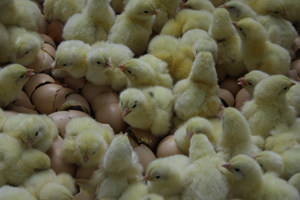In ovo feeding for stronger leg bones

Current broilers may suffer from leg problems. Previous research in the lab of the Hebrew University of Jerusalem, showed that between E17 and hatch the yolk contains low P, Cu, Mn and Zn reserves and respectively their uptake by the embryo is low.
As the skeletal system is dependent upon such minerals for its proper development, this may be a nutritional limitation which could hinder bone development.
To examine if the supplementation of minerals and vitamins improve bone development 300 eggs were incubated and divided to two groups: Enriched (on E17 with a solution of PO4, organic Cu, Mn and Zn, and vitamins A, E and D, by In Ovo feeding methodology) and untreated control.
Hatchlings were raised and tibiae (N=8) were taken at hatch, d7, d14, d28 and d54 for ash content and biomechanical testing. The cortical and cancellous structure and mineral density (BMD) of the bones were analysed.
Results show that at hatch and on d14, the enriched group had higher stiffness and maximal load than the control. On d7 the cancellous bone of the enriched group had higher trabecular thickness and bone percent than the control. On d28 and d54 the enriched group had increased bone mineralization (BMD or ash content). In summary, supplementation with minerals and vitamins positively affect bone properties. This may suggest that elevating the mineral content of the egg (either by In Ovo feeding or by elevated organic mineral levels in breeder flocks diet) may improve bone development and reduce leg problems in broilers.
Source: R. Yair, R. Shahar and Z. Uni
Faculty of Agriculture, Hebrew University of Jerusalem, Rehovot, Israel, Proceedings of the XIVth European Poultry Conference, June 2014, Stavanger, Norway












